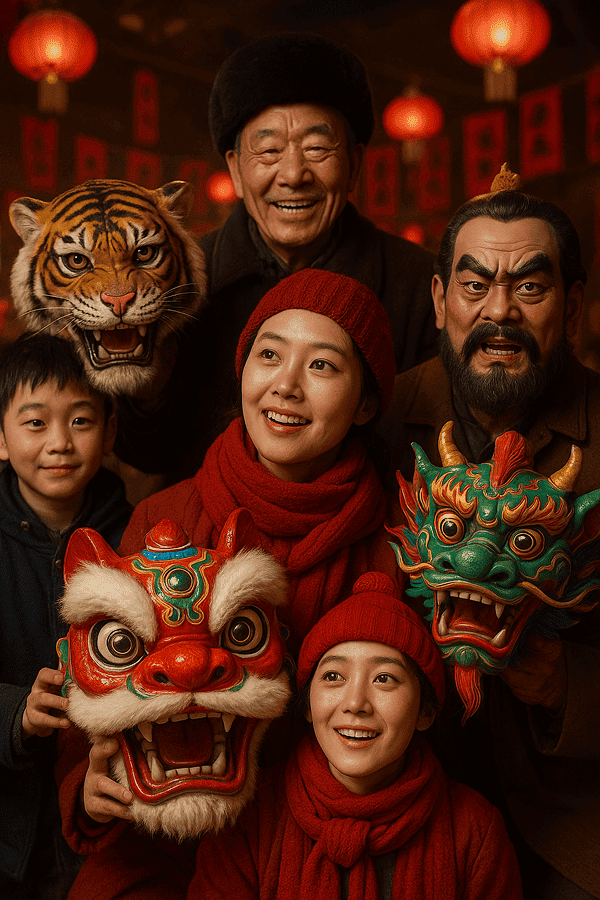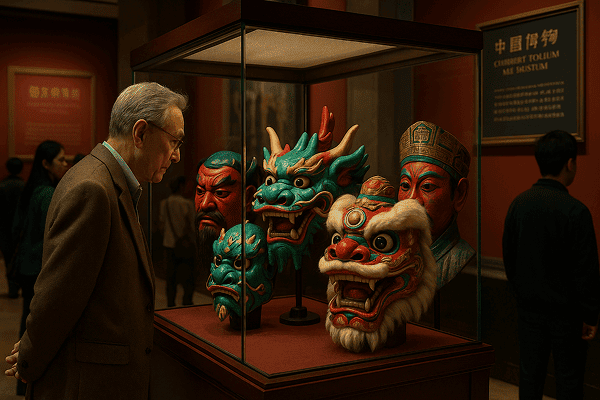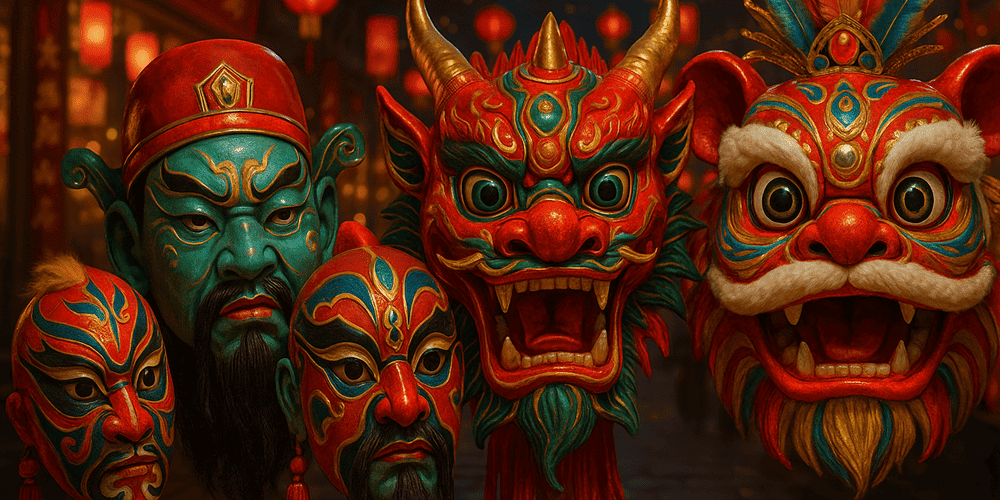Spring Festival Masks are a vibrant and beloved element of Chinese New Year celebrations, known locally as “Chun Jie Mian Ju” (春节面具). These festive masks are instantly recognizable for their bold colors, exaggerated expressions, and dynamic animal or mythical motifs. Often featuring lions, dragons, tigers, or legendary characters from Chinese folklore, Spring Festival Masks are designed to awe, delight, and ward off evil spirits. Traditionally, they belong to the broader tapestry of Chinese folk culture, with roots in regional customs stretching back more than a thousand years. Today, they are an integral part of the Spring Festival (Chinese New Year), which is celebrated across China and in Chinese communities worldwide.
Historical Origins of Spring Festival Masks
The history of Spring Festival Masks is deeply intertwined with the origins of the Spring Festival itself — a tradition that dates back to ancient agrarian rituals marking the end of winter and the coming of spring. The word “mian ju” (面具) simply means “mask” in Chinese, while “Chun Jie” (春节) designates the Spring Festival. Masks likely originated from early shamanistic ceremonies and exorcism rites, where villagers donned fearsome visages to frighten away evil spirits and usher in good fortune for the new year. Over centuries, these ritual objects absorbed influences from Daoist, Buddhist, and Confucian traditions, evolving in both function and design. The Tang (618–907 CE) and Song (960–1279 CE) dynasties saw the popularization of masked performances and dragon-lion dances, with masks becoming more ornate and theatrical. Historical texts, such as the ancient “Book of Rites” (礼记, Lǐjì), reference the use of masks in New Year and seasonal ceremonies, while archaeological finds from tombs and temple sites provide concrete evidence of their longstanding role in Chinese society. The Han Dynasty Masks, for example, offer a fascinating comparison in the evolution of ceremonial mask traditions.
Cultural Significance and Symbolism of Spring Festival Masks
Spring Festival Masks are rich in symbolic meaning and play a key role in the collective imagination of Chinese culture. At their core, these masks are believed to protect families and communities from misfortune, disease, and evil spirits during the precarious transition from one year to the next. Animal motifs, such as lions, tigers, and dragons, symbolize strength, good luck, and prosperity. The dragon, in particular, is a potent emblem of vitality and renewal, while the lion represents courage and protection. Many masks are also inspired by legendary heroes and immortals from Chinese opera and mythology, such as Zhong Kui, the demon-queller, whose fierce visage is said to scare away malevolent forces. The social context of mask-wearing is deeply communal: performances and parades bring together people of all ages, reinforcing bonds of family, neighborhood, and tradition. Through these rituals, the mask becomes a living symbol of cultural continuity, hope, and celebration.

Materials and Craft Techniques of Spring Festival Masks
Traditional Spring Festival Masks are crafted from materials that are both accessible and symbolic. Historically, artisans used papier-mâché, wood, bamboo, cloth, and clay, each chosen for its flexibility, strength, and spiritual resonance. The process often begins with shaping the base — either carved, molded, or layered — before adding layers of bright paint, lacquer, or decorated paper. Artisans employ brushes, carving tools, and sometimes even their hands to sculpt and paint the intricate designs. Decorative elements such as feathers, sequins, metallic foils, and tassels are added to enhance the mask’s visual impact and festivity. Regional differences are evident: masks from northern China tend to be larger and more dramatic, while those from southern regions like Guangdong or Fujian may be lighter and more delicate. Color symbolism is essential — red signifies happiness and luck, gold and yellow represent wealth and royalty, black denotes authority and protection, and white can symbolize purity or, occasionally, the supernatural. Each detail is carefully chosen to amplify the mask’s power and appeal.
Functions and Contemporary Use of Spring Festival Masks
The primary function of Spring Festival Masks is ritual and performance. They are worn during the famous lion and dragon dances, temple fairs, and street parades that animate the Chinese New Year. Dancers and revelers use masks to embody mythical creatures or legendary figures, acting out stories that blend entertainment with spiritual purpose. In some regions, masks are also used in “Nuo opera” (傩戏, Nuo Xi), an ancient exorcism drama with roots in pre-imperial China. Over time, the use of masks has shifted from strictly religious ceremonies to festive, theatrical, and even commercial contexts. Today, Spring Festival Masks appear in schools, cultural centers, and tourist attractions, as well as in digital formats and modern art. Their adaptability ensures that the tradition remains alive and relevant, even as Chinese society continues to change.
Regional Variations in Spring Festival Mask Traditions
Spring Festival Masks showcase pronounced regional diversity across China’s vast landscape. In northern provinces like Shanxi and Shaanxi, masks are often bold, oversized, and painted with intense reds and golds. In the south, particularly in Guangxi and Yunnan, masks tend to be lighter and more intricately carved, sometimes featuring animal fur or silk ribbons. Each region incorporates local legends, dialects, and artistic styles, resulting in a wide array of forms and traditions. For example, the Nuo masks of Hunan and Jiangxi are renowned for their fierce, exaggerated features and are used in both Spring Festival and exorcism rites. Comparisons with mask traditions in neighboring countries, such as Korean Tal masks or Japanese Oni masks, reveal similarities in function (warding off evil) but distinct differences in style and performance.
Famous Examples and Museum Collections of Spring Festival Masks
Some of the most celebrated Spring Festival Masks can be found in China’s major museums and folk art centers. The National Museum of China (Beijing) and Shanghai Museum hold extensive collections of traditional masks, including rare examples from the Ming and Qing dynasties. The Hunan Provincial Museum features an outstanding display of Nuo masks, while the Chinese Folk Art Museum in Beijing regularly exhibits Spring Festival Masks from across the country. Historical finds, such as masks unearthed from ancient temple sites or preserved in private collections, offer invaluable insight into the evolution of mask-making techniques and styles. Internationally, museums like the British Museum and the Asian Art Museum (San Francisco) also showcase Chinese festival masks, helping to share this rich tradition with a global audience. For a comprehensive digital experience, resources like toddmasks.com provide virtual galleries and expert commentary.

Influence of Spring Festival Masks on Art and Culture
The impact of Spring Festival Masks extends far beyond holiday celebrations. Their bold designs and expressive forms have influenced Chinese painting, sculpture, stage design, and even contemporary fashion. Traditional mask motifs appear in literature, cinema, and visual arts, where they symbolize transformation, protection, and the triumph of good over evil. In popular culture, images of lion and dragon masks are ubiquitous during New Year festivities, both in China and in overseas Chinese communities. Modern designers often draw on mask aesthetics for jewelry, textiles, and home décor, blending ancient symbolism with contemporary creativity. By inspiring new generations of artists and performers, Spring Festival Masks play a vital role in preserving and renewing Chinese cultural heritage.
Modern Status and Preservation of Spring Festival Mask Traditions
Today, the tradition of Spring Festival Masks is experiencing both revival and reinvention. Master artisans and folk art schools across China are dedicated to preserving traditional techniques, often passing their skills down through apprenticeships and family workshops. Government and cultural organizations support mask making through festivals, competitions, and educational programs. Innovations abound, as artists experiment with new materials, digital media, and cross-cultural collaborations. Academic institutions and museums — including those highlighted on toddmasks.com — play a crucial role in research, preservation, and public education. Masterclasses and online tutorials have made mask-making more accessible than ever, ensuring that this ancient art continues to thrive in the modern era.
Collecting and Acquiring Spring Festival Masks
The market for Spring Festival Masks is lively and diverse, spanning traditional folk art shops, artisan studios, and online platforms. Authentic masks, especially those handcrafted by renowned masters or from historic regions, command higher prices and are prized by collectors worldwide. Prices vary depending on age, craftsmanship, materials, and provenance. When acquiring masks, collectors should seek expert advice, verify authenticity, and prioritize ethical sources — supporting local artisans and respecting cultural heritage. Institutions like toddmasks.com offer guidance on identifying genuine works and navigating the art market. As with all cultural artifacts, it is important to honor the traditions and communities that sustain this living heritage.
